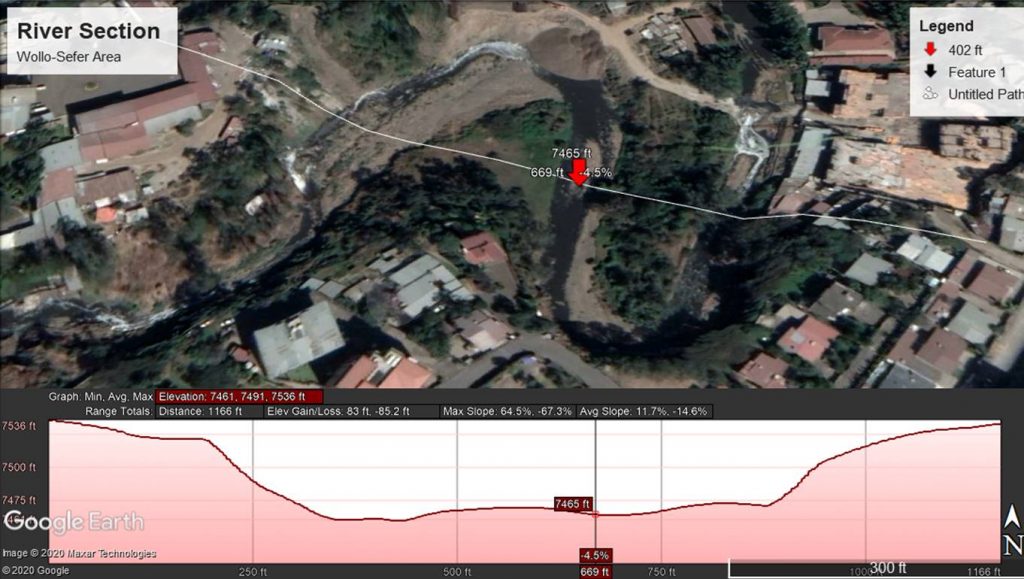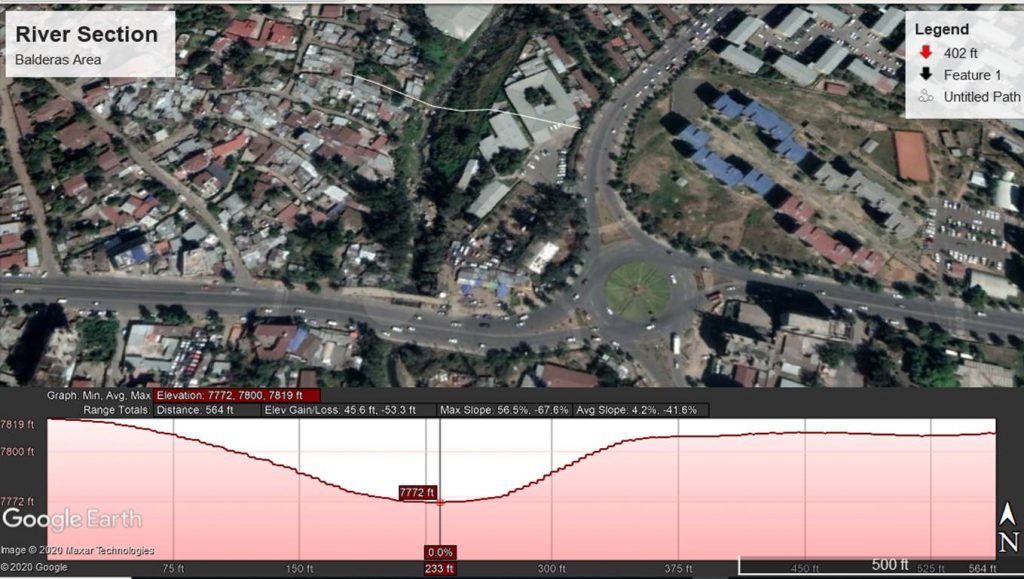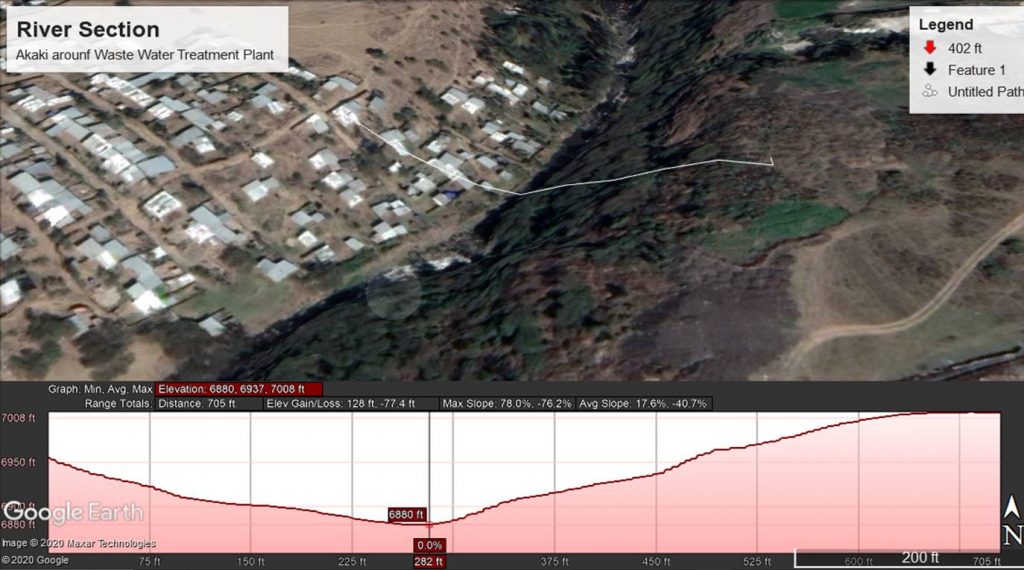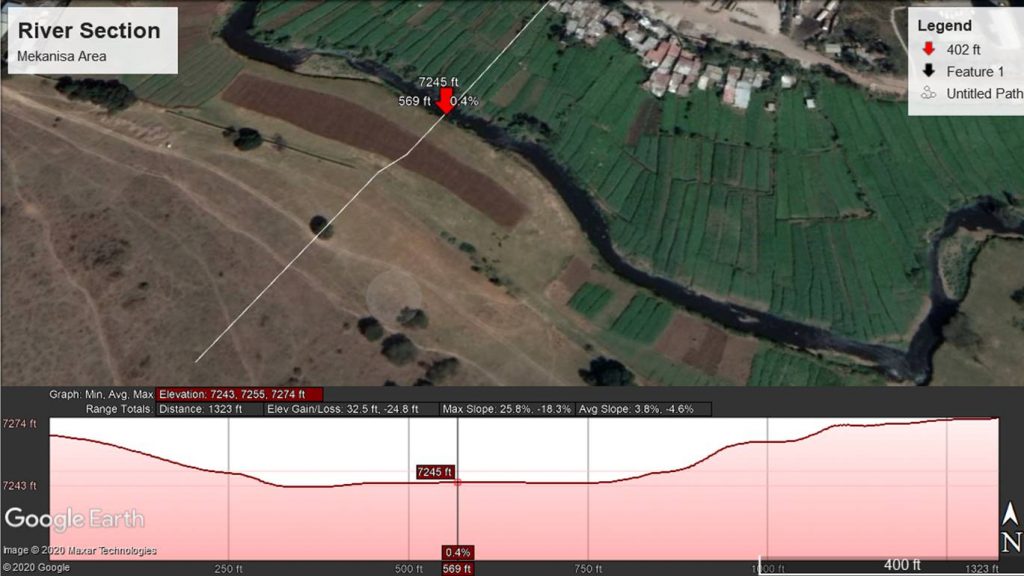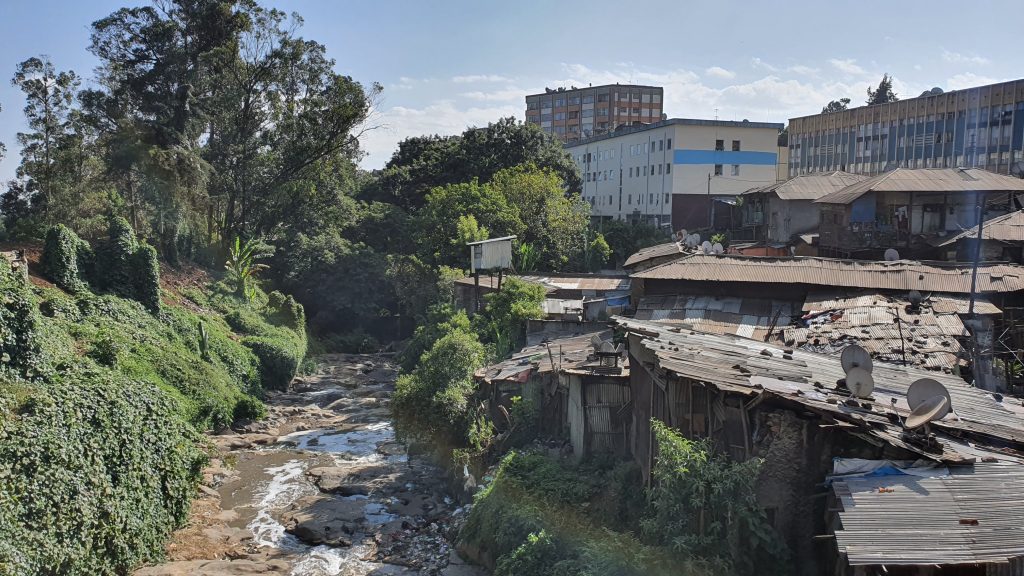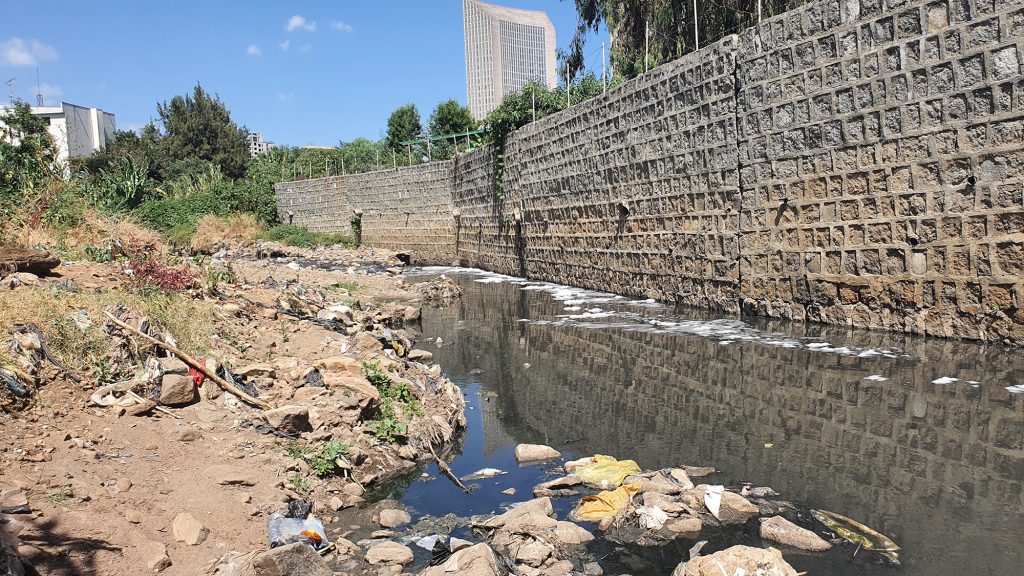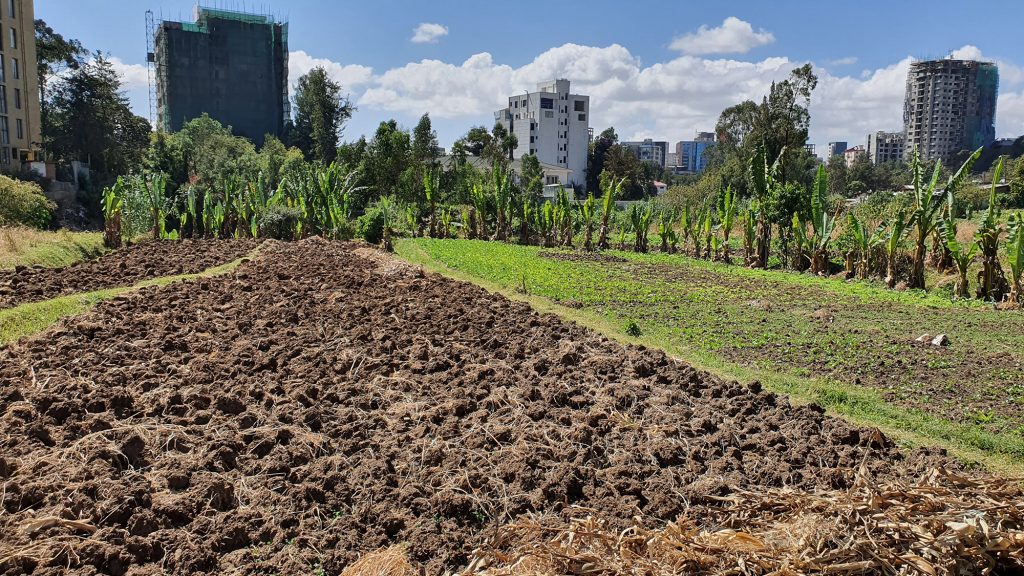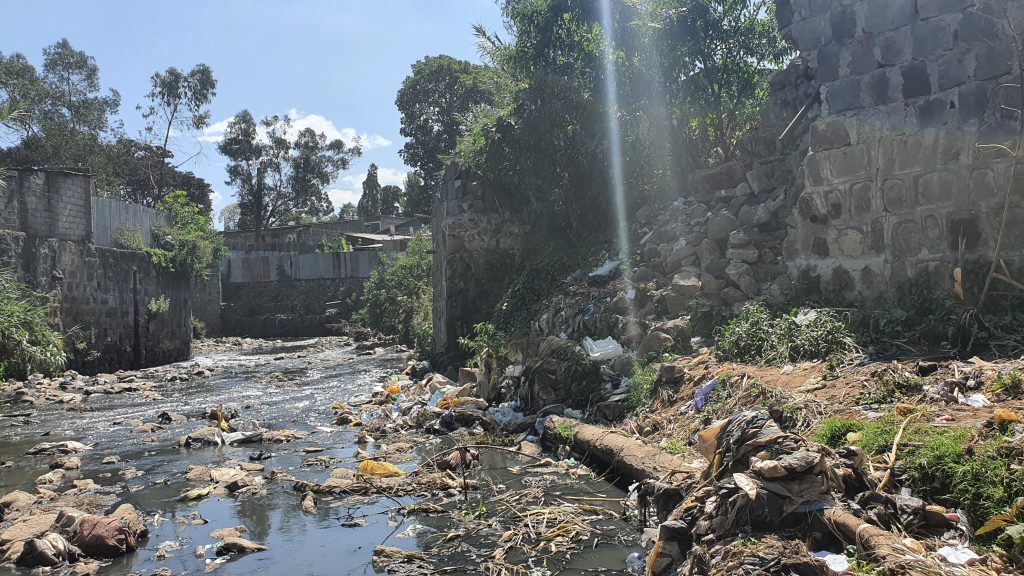THE DANGER OF AMBITION AND NEGLECT
The Case of Beautifying Sheger
December, 2020
—
sinkneh eshetu, aziza abdulfetah busser & berhanu
I. Introduction
Comparing the current prime minister of Ethiopia, Abiy Ahmad, to his predecessors, Briuk Terrefe writes: “Abiy Ahmed’s two megaprojects [the 36-hectare luxury real estate complex (LaGare) backed by the Abu-Dhabi-based Eagle Hills, as well the 56 km river-bank restoration project, Beautifying Sheger] represents a clear ideological rupture from EPRDF1The Ethiopian People’s Revolutionary Democratic Front. and its political priorities, while at the same [time] continuing the long Ethiopian lineage of overly ambitious plans, as well as highly centralized and top-down mechanisms of delivery.”2Terrefe, B. (2020). Urban layers of political rupture: the “new” politics of Addis Ababa’s megaprojects. Journal of Eastern African Studies. DOI: 10.1080/17531055.2020.1774705. This places the subject of this research within the wider context of “political rupture” and societal change. Regardless of whether one agrees with his analysis or not, we can be sure that the urban fabric of Addis Ababa is about to undergo a dramatic change.
It has been consistently observed around the world that such rapid and large-scale transformations are disruptive to people’s lives (particularly to the economically disadvantaged) and the natural environment. Beautifying Sheger, which aspires to create a city-scale public space by transforming the neglected and polluted rivers of Addis Ababa3Concept Note. (May 18, 2019). Addis Ababa City River Side Green Development. will inevitably disrupt the ecosystem, as well as the livelihood of thousands and over a century of collective cultural memory. This is the case our team is working on as part of the research-based art project, As You Go … The Road Under Our Feet Towards a New Future.
For an apt treatment of a project of such a scope, we began with the cultural landscape as the conceptual framework of our research. Using this framework allows us to see the integration of natural and cultural heritage conservation at a landscape level, rather than at a site-level. This encourages us to give due consideration to the landscape; its historical scale; and the connectivity between people, places, and cultural objects. It also enables us to recognise that the current landscape is the product of long-standing and complex interrelationships between people and the environment.4State of NSW and Department of Environment and Climate Change. (2008). Cultural landscapes and park management: a literature snapshot – a report for the cultural landscapes: connecting history, heritage and reserve management research project. Sydney South, Australia.
When we began this project, we had three major objectives. The first was to investigate the impact of the project on the ecosystem, and on the memory and livelihood of the people, focusing on gardeners along the rivers who use the river water, though polluted, for irrigation. Another objective was to explore alternative designs for [a] sustainable culture-nature fit by reviewing literature on international trends, experiences, and better practices in urban river rehabilitation or re-naturalization. The final (but not the least) objective was sensitising authorities and the public to the probable impact of the current design and construction process on the people and ecosystem through public engagement.
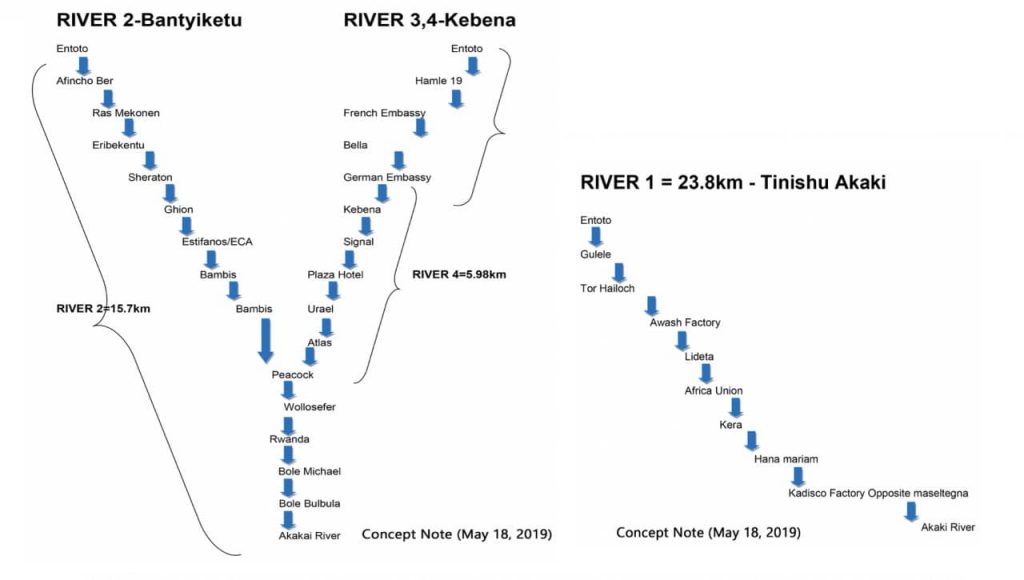
Abstracted images of the rivers targeted in the Beautifying Sheger River Development Project5Concept Note. (May 18, 2019). Addis Ababa City River Side Green Development..
However, as our research progressed, mediated by the tele-conferences among the partners (cells) of the As You Go … project, another important issue came to the fore. Landscape architectures is often regarded as an external manifestation of the inner landscape of a society. The realisation of the designer’s vision and ideals is a process that encompasses conceptualisation, design, implementation, and management – therefore, the cultural background, experience, and philosophy of the designer(s) must be a significant consideration. Alongside this, the participation of the public, professionals and non-professions alike, becomes paramount in a project of this scale,
As we began our research, we learned that the initial landscape design of the Beautifying Sheger riverside development, used in the promotional video released by the PM’s office and Addis Ababa City Administration, is not being implemented. Instead, a new design developed by a Chinese landscape architect for the pilot project is now underway. Moreover, the construction of the pilot phase of the project, which was originally awarded to an Addis-based construction company, Varnero, in February 2019, was subsequently withdrawn. It was given to the China Communications Construction Company (CCCC) after the Chinese government agreed to fund the project following PM Abiy’s debt rescheduling negotiations at the Belt and Road Forum in April 2019.6Terrefe, B. (2020). Urban layers of political rupture: the “new” politics of Addis Ababa’s megaprojects. Journal of Eastern African Studies. DOI: 10.1080/17531055.2020.1774705. Local professionals are now only involved as private consultants in the construction process. As a result, analysing the conceptualisation of the design, labour relationships, and use of technology in the construction process, as well as the role of China in the future management of the designed landscape, has now become an additional objective.
II. Background of the Study Area
1. Historical Overview
The history of Addis Ababa is important to understand in order to begin to comprehend the layers of collective and cultural memory; the spirits of places; the spatial patterns; the ecological links; the contested interests; the impacts of change, and the direct and indirect recipients of the impact. Unlike other cultures, such as Egypt, who built their cities and civilization along rivers, Ethiopia does not have any cities near its major rivers. Even the establishment of the youthful Bahir Dar, which lies in close proximity to Lake Tana and River Abai (the Nile), is arguably not dependent on these waters. Addis Ababa is no exception. Its establishment and growth are not principally driven by its rivers – though interestingly, it was one of its hot-springs that offered the initial impetus for the city’s foundation and ended the shifting of Ethiopian capitals.
In 1886, the wife of King Menelik, Queen Tayitu, camped at the Filwuha hot spring. Preferring the warmth of [the] Finfine plains to the windy and cold hill of Entoto, she decided to build a house to the north of the spring. With this humble beginning, Ethiopia’s capital would soon shift downhill, and in 1906, it changed its name from Entoto to Addis Ababa (translating to: New Flower). Menelik’s generals were given encampments (sefers), interspaced by long distances, to settle in the new capital with their army and relatives. As a military strategy, both the emperor and his generals preferred hills to river valleys and floodplains. Most of the spaces along these unplanned settlements would gradually be filled with similarly unplanned neighbourhoods – particularly near the rivers of the newly forming city, which was left for the slum-like settlements of Addis Ababa’s poor. Emperor Haile Selassie (1892-1975) eventually introduced a diligent planning and provision of infrastructures. The Italian occupants, who interrupted the reign of Emperor Haile Selassie for five years (1936-1941), brought about further planning and construction, and contributed to the development of riverside gardening by building micro-dams for irrigation. When the socialist Derg (1974-1987) made land ownership public, many of the riverside settlements and farms consequently became public property. To this day, they remain mostly owned by woredas/District.
Addis Ababa was not built on Terra Nullius (No One’s Land).7Reference to Captain James Cook (1728-1779) who used this term, employed by the British, to justify occupation of a territory on behalf of the Crown, when they claimed possession of Australia. It is surrounded and preceded by farming communities, and historically and religiously important heritages. This is particularly the case with Entoto, where centuries-old ruins of buildings and rock-hewn churches abound. Though professionally studied literature on these ruins are lacking, some believe that they are related to the fabled city, Barara, referred to in the chronicle of Ahmad Gragn (1506 – 1543). Working within our framework of cultural landscape, the city’s long history will also be considered to explore whether its heritage, which enhances the spirit of places (genius loci) within the project area and offers alternative narratives, is capitalized on and integrated into the new landscape design of Beautifying Sheger.

Some of the remains of ancient buildings on Entoto Hill, showing a long history of settlement
(Credit: Sinkneh Eshetu, 2014)
2. Characteristics of the Addis Ababa Rivers
Addis Ababa’s rivers have hydrological and morphological properties that make their development challenging. The rapid expansion of the city added another layer of complexity to this challenge. The nature of the rivers’ network, elevation differences, soil characteristics, hydrological systems, and their geology gives the rivers of Addis Ababa unique characteristics and irregular behaviour as they pass through the different parts of the city.
The river network is estimated to cover about 54 kms and passes through almost all neighbourhoods. As a result, the human-river interaction – the social, cultural and economic attachment between the rivers and the city dwellers – is significant. The rivers’ characteristics, which differs from site to site, highly affects the day to day life of the majority of its inhabitants.
The elevation difference between the highest point (Hill Entoto) and the lowest (Akaki catchment) is more than 900m within a distance of about 27 kms. The resulting slope, combined with the riverbank width, results in a rapid flow rate. Favoured by the topography, this rapid flow makes many places adjacent to the rivers prone to flooding.
In addition to the overall altitude difference, the riverbanks have different sectional views adapted to the local topography. There are also areas with unstable edges, characterized by an accumulated layer of thick top soil. Due to the fact that the volume of water in the river significantly increases during the rainy seasons, such soft edges are the most susceptible areas for landslide accidents.
The diverse bank characteristic of Addis Ababa Rivers (Source: Google Earth Pro. Picture taken 12, 2016. Retrieved on 12/03/2020 from 23:21 to 12:08 AM)
3. The Role of China in the Design, Construction and Management
As stated earlier, the construction of the pilot project of Beautifying Sheger is contracted to China Communications Construction Company (CCCC). CCCC commenced the first phase in October 2019 and completed it by the end of August 2020. It outsourced the second phase to the Nantong 3rd Construction Company for another 14-month long construction. Echoing the significance of the project to PM Abiy’s administration, both the Ministry of Foreign Affairs and Ministry of Commerce of China rate [it] as their “No. 1” international project and one of their key foreign aid projects.8Note: the Chinese government has a slightly different definition for “aid project” (yuanzhu gongcheng) which follows market principles (Deborah Brautigam 2009:115). The content of these so-called aid projects can vary case by case. Typically, large construction projects involve the client, constructor, supervisor, and loaner. In other projects contracted to Chinese companies, the Ethiopian government and the International Development Association are often the clients, and the projects are financed through Chinese banks such as Sino Eximbank. Since its commencement, PM Abiy, high-rank officials, and many generals are among the frequent visitors to the construction site. One of the state leaders even volunteered to explain the project details to other site visitors – allegedly, he even has a watchtower built near the PM residence to check on the progress of the construction.9CCCC Wins the Contract of Riverside Project, Erecting a Stele of Development and Friendship. http://www.zgzjwx.org/detail/2d0kjg.html. Access Time: September 10, 2020.
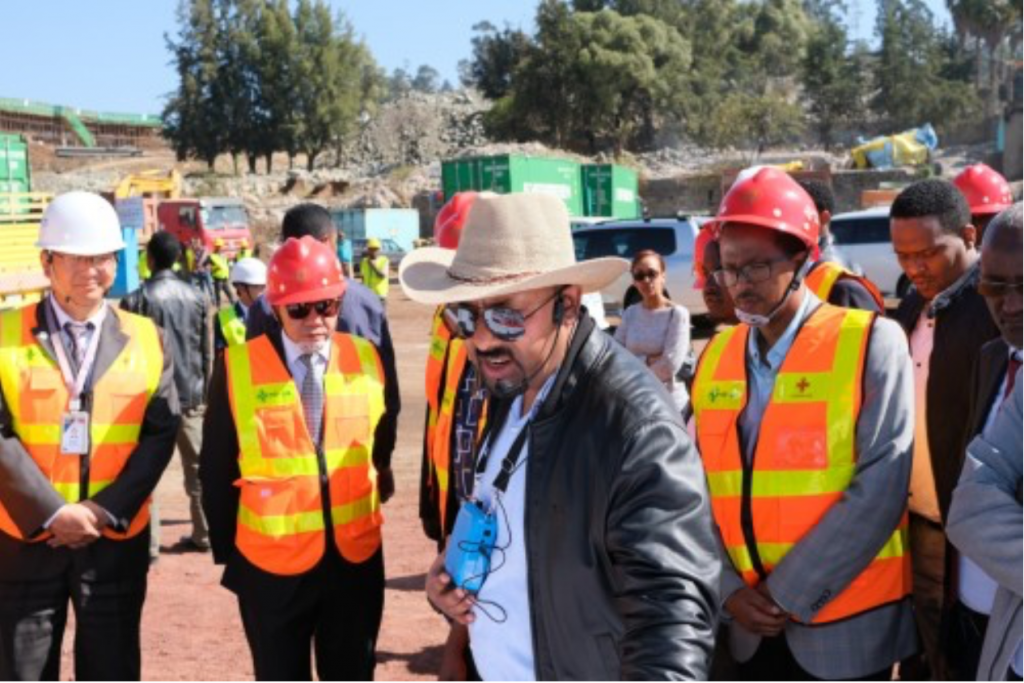
PM Abiy visits the construction site. Source: http://www.zgzjwx.org/detail/2d0kjg.html
The diplomatic and political significance of the Sheger project requires an enormous coordination and mobilisation of resources from China’s side. Accordingly, the Ministry of Commerce has prioritised an allocation of funds to this project. China’s ambassador to Ethiopia, Tan Jian, and CCCC higher management have managed to coordinate the logistics of materials to the site, as well as human resources and equipment from 20 other construction projects in Ethiopia. The staff members from China’s Urban Construction Academy and the primary designer stationed themselves at the site of the podium and worked overnight to solve emerging issues. The CCCC engineers are said to have shortened the production of executable blueprints from several months to only 15 days.
With scant information from the CCCC, we nevertheless try to offer a portrait of the project based on literature, open resources, and past research experiences. The negotiation, mobilisation, and construction process of the Sheger project – which like many other megaprojects, underlies the famous “Chinese speed” – has domestic roots, though it evolved in international contexts. Since the 1990s, Chinese construction companies have become accustomed to the harmonised government–construction consortia relations that they cultivated domestically.10Derissen, Miriam. 2019. Tales of Hope, Tastes of Bitterness: Chinese Road Builders in Ethiopia. Hong Kong University Press. Winning a government contract – and support – is critical for the smooth implementation of projects (and projects in these international contexts, at times even offset Chinese companies’ unfamiliarity to local cultural and legal conditions.)11For instance, in examining a road construction program in Ethiopia, Driessen (2019) argues that Chinese ignorance of Ethiopia’s labour regulations, as well as the legal protectionism, stems intrinsically from Ethiopia’s political system in which the local state is marginalised in federal-initiated road programs; and it is the local states which often bring Chinese companies to court. Through court decisions, the local administrations form a de facto alliance with local workers [to instead] push through a number of design revisions beneficial to local communities [though without necessarily requiring the consultation of local experts or expertise].
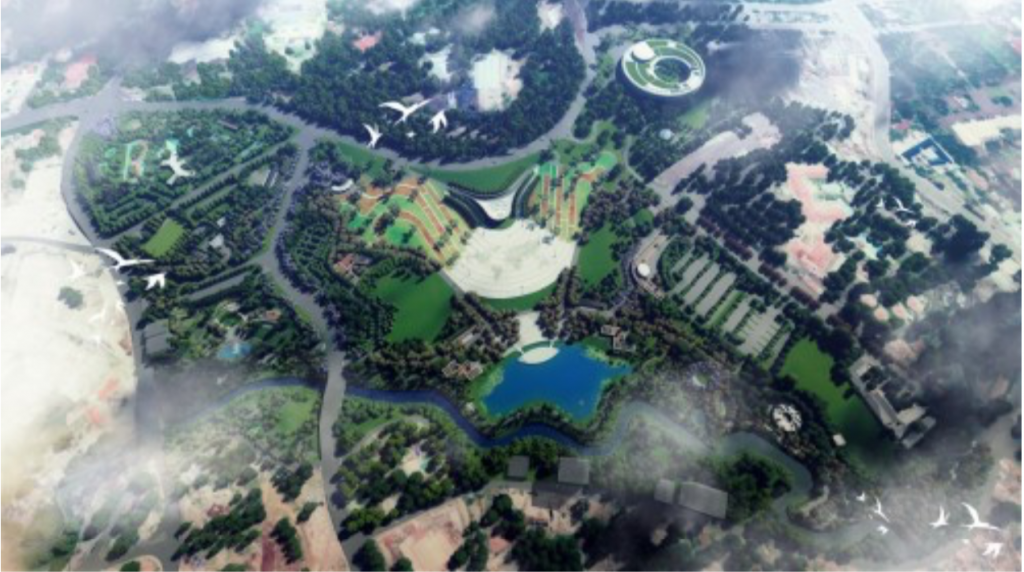
Design blueprint of Phase I. source: http://www.zgzjwx.org/detail/2d0kjg.html
Taking Ethiopia as an example, we may consider the nature of large overseas projects the Chinese has been involved with before the Belt and Road initiative. China’s presence within the country goes back to the 1970s, when Emperor Haile Selassie and PM Zhou Enlai signed a project to build a 300km long gravel road in the Amhara region. The year 1997 witnessed the first Chinese company entering the Ethiopian construction market building the Addis Ababa ring road. Like elsewhere in Africa, the infrastructural developments Chinese companies have been involved in, though termed as an aid project in the PRC’s documents, are in fact projects tied to the resources or revenue of the recipient countries. They mainly filled the gap left by traditional donors who shifted away from infrastructure to humanitarian aid.12Bräutigam, Deborah. 2009. The Dragon’s Gift: The Real Story of China in Africa. Oxford University Press.
In the case of Sheger, the nature of the contract is on an EPC basis according to a Chinese subcontractor to CCCC. An EPC project means that the engineering, procurement, and construction responsibilities fall on the constructor. While this allows the constructor to streamline and integrate processes at their discretion – in this case, turning to a top-down mobilisation and coordination of human and material resources from China (80% of the total) and other CCCC projects in Ethiopia – such “turn-key” projects keep local input to a minimum. In case of Beautifying Sheger, both the designer and site supervisor are from China’s Urban Construction Academy rather than Ethiopian consultant companies. As a result of the closed nature of the project, our requests to interview Chinese staff members have been politely declined.
The mobilisation mode of the construction giant CCCC is exemplar among China’s state-owned enterprises, which often uphold discipline and sacrifice for collective purposes – a socialist working ethos, with its pedigree from the Stakhanov movement in the Soviet Union. In another project contracted to a Chinese Special Operatives Executive (SOE) in Addis Ababa, whenever VIPs or political leaders (both Ethiopian and Chinese) are about to visit the construction site, engineers and workers have to conduct shock work, and their performance and preparedness are linked to opportunities for promotion. In other words, both the management and engineers are directed by a mix of collectivism and career instrumentalism.
Many overseas projects of Chinese construction companies hire skilled domestic workers through labour companies, however, skilled Chinese labourers are still favoured by Chinese companies, or occupy a higher niche than local labourers, because of their familiarity with Chinese technical standards (Ethiopians follow EU, US, or Ethiopian standards) and the ease of communication in Chinese. Many Chinese workers are from rural areas, or are the second generation of so-called peasant workers, who gravitate to foreign countries because they can earn a much higher salary and [can] subsequently buy an apartment in China’s cities.13Derissen, Miriam. 2019. Tales of Hope, Tastes of Bitterness: Chinese Road Builders in Ethiopia. Hong Kong University Press. Carrying their parents’ puritan work ethic, these workers remain quite adaptable to the intense workloads overseas, in the hope that they may climb up the social ladder in Chinese society.
Thanks to the nature of the EPC contract, the integrated supply chain; the mobilisation model (characteristic of the overseas project of the SOEs); and the incentive structure of the Chinese management and workforce all contribute to the everyday progress of the project. Biruk Terrefe argues that the Beautifying Sheger project represents a form of urban aesthetics targeting urban elites, the Ethiopian diaspora, and tourists; and that there exists the operational continuity of planning centralisation.14Terrefe, B. (2020). Urban layers of political rupture: the “new” politics of Addis Ababa’s megaprojects. Journal of Eastern African Studies. DOI: 10.1080/17531055.2020.1774705. The quick accomplishment of the project will no doubt be a positive political asset to PM Abiy Ahmed, but it also represents the enormous power of states and a triumph of their collective hyper-modern imagination of grandeur, minimalism, and speed. It is unavoidable that local expertise; the complexity of the riverside landscape; the livelihood and memories of the inhabitants; and the nature and ecology of the Addis rivers are all sidestepped and silenced.
III. THE PROJECT: BEAUTIFYING SHEGER
1. Existing Condition of the Rivers
Over a century of neglect and mismanagement made the Addis rivers a site of informal settlement, landfills and open defecation, outlets of domestic sewers and factory pollutants, deeply eroded gullies and high retention walls, and wild vegetation. Meanwhile, important infrastructures such as waste and storm water lines, roads, bridges, powerlines, and telecom cables criss-cross them. Our site visit to the parts of the river targeted in the pilot project reveals that there are still urban farms using polluted water for irrigation, with informal and formal settlements often precariously hanging off the deep gullies.
The current state of the rivers targeted in the pilot project of Beautifying Sheger, clockwise: informal settlement side to side with modern buildings, urban farm, high retention wall and landfills (Picture: Sinkneh Eshetu, 2020)
Other than during the rainy seasons, the water in the rivers is not actually natural water but rather, domestic sewer and factory releases. In the rainy seasons, which only happens twice a year, the rivers often overflow at some points, causing flooding hazards. Researches have shown that the storm water which heavily contributes to the seasonally rising rivers is increasing with the growing urbanisation that creates impervious surfaces.15Beyene, M. N. (June, 2016). Urbanization and Its Effect on Surface Runoff: A Case Study on Great Akaki River, Addis Ababa, Ethiopia. Addis Ababa University, Addis Ababa Institute of Technology. Parts of the rivers run through enclosed culverts for long distances, intensifying the pressure of the water downstream. The rivers pose a high risk to public health and wellbeing, which only continues to grow with the rapidly increasing buildings and population that have no provisions of fitting infrastructure and services.
One of the results of the unplanned development of Addis Ababa is the co-existence of slum dwellers with the urban fluent. In recent years, there has been a rapid makeover of the face of Addis, which often involves the displacement of slum residents. The riversides are no exception. Modern buildings and high rises are rapidly encroaching these places, often buying out and dislocating people, building more concrete embankments, and further contributing to the liquid and solid waste. Unlike these ad hoc changes, Beautifying Sheger targets the entire river system and promises to mitigate the negative impacts posed by the former. Most likely encouraged by the rising land value (following the transformation of the rivers with the riverside development project), new buildings are sprouting along the river. This further transforms the existing ecosystem, urban fabric, and sub-culture.
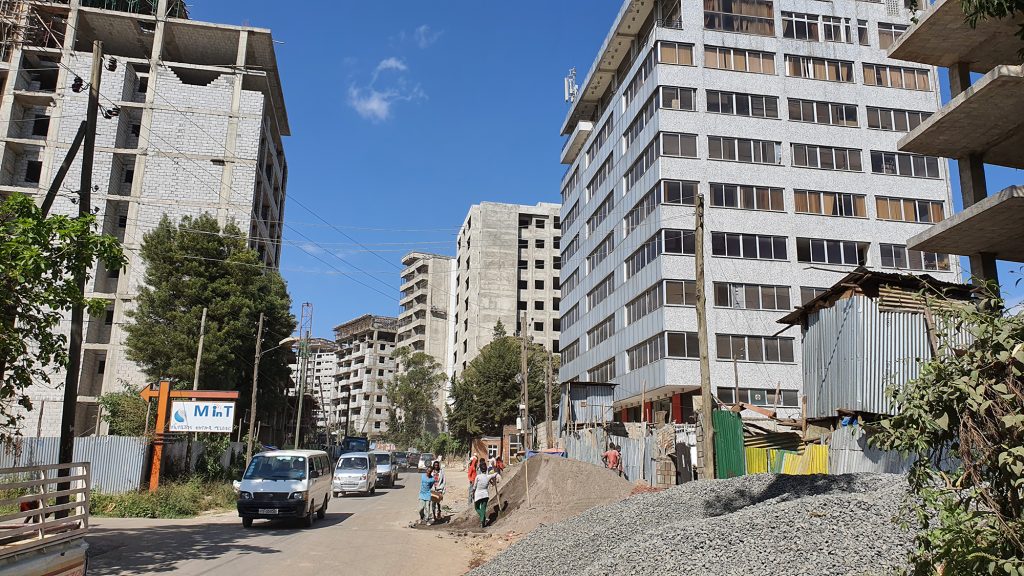
New buildings along a street near the newly built Friendship Square. (Picture: Sinkneh Eshetu, 2020).
2. Earlier Efforts at Riverside Development
The effort to clean and beautify Addis Ababa’s rivers is not new. An independent office, Addis Ababa Rivers and River side Development Project Office, was also established in early months of 2016 (addisstandard, March 6, 2019). Other organizations, such as Addis Ababa Environment Protection Authority (1995), Addis Ababa Beautification, Parks and Cemetery Development Agency (2009), Forum for Environment Ethiopia (1997) and Tena Kebena (1993), have also been trying to clean the landfills and create public spaces near the rivers. However, these sporadic efforts failed to explicitly target to clean the rivers of their pollution sources or connect the entire river system in series of green spaces, which Beautifying Sheger promises to do.

Earlier efforts at restoring the river bank, an area part of the pilot project (Pictures: Sinkneh Eshetu, 2020).
3. The Current Project: Concept Note, Design and Construction
According to the project Concept Note, Addis Ababa City Riverside Green Development (May 18, 2019), the project aims to: make the river watershed clean and healthy, create public spaces along the rivers, and increase the green space in the city. It plans to achieve this through concrete embankments along the rivers; erosion and runoff control structures wherever necessary; waste and storm water lines, and water treatment plants along the rivers; and artificial lakes for irrigation. The concept does not propose public participation in the design and implementation process, though unemployed people affected by the project will be offered jobs as day laborers at the construction site. While it admits this project may involve the relocation of people within the buffer zone, it promises to allow existing farmers to continue ‘owning’ and managing their gardens even after the completion of the project.
However, whether or not these measures are to be incorporated in the current and future design and construction, raises a number of questions:
· What justifies the recommendation that the entire river bank will be lined with concrete embankments?
· Are the existing sewer and storm water lines of the city combined? Will the sewer and storm lines proposed to be built along the river also be combined?
· Given that most of the water running through the riverbeds in dry seasons is from sewer and storm water lines, where will the water flow into the rivers from if separate sewer and storm water lines are to be built?
· If, in dry seasons, the river water is expected to come wholly from the water treatment facilities, will this be enough to create running rivers throughout the dry seasons?
· Can the storm water hazards during the rainy season only be controlled by in situ measures, or are there measures to be implemented beyond the immediate vicinity of the rivers?
· Are the existing and proposed heavy retention walls and flood control structures necessary if the storm water control measures mentioned above are implemented?
4. The Construction Process
The pilot project is expected to be completed in approximately mid-2020 to coincide with the 50thanniversary of the China-Ethiopia diplomatic tie. In fact, part of the project, named Friendship Square, was inaugurated on September 10, 2020 on the Ethiopian New Year. However, the park is not yet open to the public, and construction work is still underway in some parts of the site.
Friendship Square is only a small part of the entire project; however, it is a good indicator for how this may transform the entire river landscape and the connected urban spaces. We have made repeated visits to the park (within its perimeters and from the outside), conducted informal interviews, and have taken photographic documentation. Among our findings is that aside from the concrete embankments, the proposed ideas in the concept note – as well as the wildly publicized design – are not being implemented.
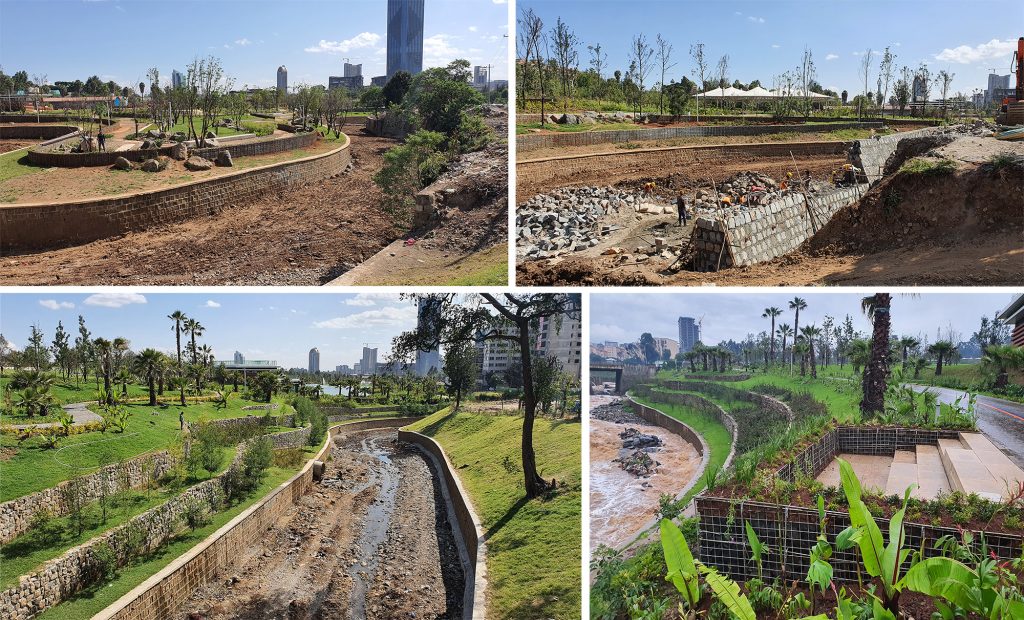
The riverside development under way and completed (Pictures: Sinkneh Eshetu, 2020)
The concrete embankment is even being built in places where the slopes are gentler; which could have been designed in a way for the people and wildlife to interact with the river, adjacent soils, and vegetation. Moreover, it is easily noticeable that sewer and stormwater lines are still emptied into the riverbeds at the completed sites, as well as in the sites under construction. This research will explore whether these are permanent outlets or will later be diverted to storm and sewer lines proposed in the concept note to be built along the rivers.
Though the Friendship Square is constructed on a site that was cleared a few years ago for another project and people are not currently being displaced, we are told that young people from the surrounding area are hired in the project in different capacities. Though we did not interview them during our visits, we have seen them working as gardeners, cleaners, and in other areas. The project will soon be expanding to the Eribekentu area that lies opposite Friendship Park, separated from it only by a road, which is still heavily populated by several informal housings which have been in existence for decades. The people in these areas have been told that they are soon be relocated. So far, they are also not formally participating in the design and construction process. Some among them expressed their wish for the project to transform the area without the need for relocation.
Works have already begun in other areas the pilot project is expected to include, such as Peacock or Central Park. This area is one of the few public parks that has been in existence for a long time. This is a flood plain where the vegetable gardens are relatively wide, engaging a large number of families. The “owners” of these gardens, some of whom have been working on the land for decades (though the land is actually owned by the public), hope that they will continue to “own” and work on their farms during the coming project. As the informal settlers and farmers are willing to be interviewed, we plan to approach them later with formal interviews to learn their attitudes and ideas about the impending change.
This research is yet to find out whether the same Chinese landscape architect, who designed the Friendship Park, will design other parts of the pilot project with or without the participation of local professionals, and whether or not the current local consultants will continue with their tangential contributions.
IV. INTERNATIONAL EXPERIENCES, TRENDS AND GOOD PRACTICES
Around the world, we are beginning to recognise that the treatment of urban river banks and other water bodies with hard infrastructure without considering the natural ecosystem causes incalculable damage. This recognition is motivating designers, as well as city administrators, to take precautions to re-naturalise urban rivers. This trend has taken several approaches which could serve as an invaluable lesson for the Ethiopian context.
We have been collecting and selecting different cases from around the world related to the re-naturalisation of urban rivers; natural flooding; erosion and landslide hazard control measures; innovations in dealing with urban complexity and heritage preservation in river rehabilitation projects; and green infrastructure, aesthetics, ecology & survival. These selected cases and lessons, with a due consideration for trends and cases in China, will be presented to the public, as well as professionals, in a way that they may generate awareness and dialogue, which may be used as input in the further design and development of Addis Ababa’s rivers.
V. Public Attitude and Engagement
A cursory review of social media about the public attitude towards Beautifying Sheger project mostly reveals support, excitement, and appreciation. Some critical voices are heard once in a while. Some of these voices consider such extravagant gardens as luxuries and suggest that this should not be the government’s priority. Others decry the further displacement of citizens and the near total erasure of public memory, which has been ongoing for years in many urban development projects.
The impact of the widely publicized Beautifying Sheger River Development project is already starting to be seen. Some other cities in the country are beginning to plan and design similar public spaces and riverside development projects. One of these designs, that of Jimma City, was recently shared on a Facebook group called Ethiopian Architecture and Urbanism16https://www.facebook.com/groups/665698490519013/?multi_permalinks=1082731795482345¬if_id=1607455244518798¬if_t=group_highlights&ref=notif. Taking this as an opportunity, we attempted to engage the public and professionals to discuss the Addis Ababa project under consideration. Another discussion was on the heritages and ruins around Addis Ababa (particularly those on Entoto Hill). Some attempts are also made to engage with key decision makers by commenting on their twitter postings. One of these comments was seen by a person in Pakistan who inquired about our findings as similar things are happening in his country.
Similar indirect engagements will continue until the research organizes its own events and discussions to sensitize authorities and the public on the probable negative impacts of Beautifying Sheger. Given our current global situation and the condition of the country (COVID-19 and the conflict in Tigray region), other strategies could be planned to safely engage the public. The informal engagements mentioned above indicate that this research has the potential to influence decisions and practices in Ethiopia and beyond it. This will be more so if well planned events are organized, and publicly sharable documentations such as videos are produced, should resources and conditions permit.
Sinkneh Eshetu (penname: O’Tam Pulto) is a published author and landscape architect.
Aziza Abdulfetah Busser is a landscape designer; practising professional architect, and academician.
Berhanu is an anthropologist in African Studies.
[1] The Ethiopian People’s Revolutionary Democratic Front.
[2] Terrefe, B. (2020). Urban layers of political rupture: the “new” politics of Addis Ababa’s megaprojects. Journal of Eastern African Studies. DOI: 10.1080/17531055.2020.1774705.
[3] Concept Note. (May 18, 2019). Addis Ababa City River Side Green Development.
[4] State of NSW and Department of Environment and Climate Change. (2008). Cultural landscapes and park management: a literature snapshot – a report for the cultural landscapes: connecting history, heritage and reserve management research project. Sydney South, Australia.
[5] Concept Note. (May 18, 2019). Addis Ababa City River Side Green Development.
[6] Terrefe, B. (2020). Urban layers of political rupture: the “new” politics of Addis Ababa’s megaprojects. Journal of Eastern African Studies. DOI: 10.1080/17531055.2020.1774705.
[7] Reference to Captain James Cook (1728-1779) who used this term, employed by the British, to justify occupation of a territory on behalf of the Crown, when they claimed possession of Australia.
[8] Note: the Chinese government has a slightly different definition for “aid project” (yuanzhu gongcheng) which follows market principles (Deborah Brautigam 2009:115). The content of these so-called aid projects can vary case by case. Typically, large construction projects involve the client, constructor, supervisor, and loaner. In other projects contracted to Chinese companies, the Ethiopian government and the International Development Association are often the clients, and the projects are financed through Chinese banks such as Sino Eximbank.
[9] CCCC Wins the Contract of Riverside Project, Erecting a Stele of Development and Friendship. http://www.zgzjwx.org/detail/2d0kjg.html. Access Time: September 10, 2020.
[10] Derissen, Miriam. 2019. Tales of Hope, Tastes of Bitterness: Chinese Road Builders in Ethiopia. Hong Kong University Press.
[11] For instance, in examining a road construction program in Ethiopia, Driessen (2019) argues that Chinese ignorance of Ethiopia’s labour regulations, as well as the legal protectionism, stems intrinsically from Ethiopia’s political system in which the local state is marginalised in federal-initiated road programs; and it is the local states which often bring Chinese companies to court. Through court decisions, the local administrations form a de facto alliance with local workers [to instead] push through a number of design revisions beneficial to local communities [though without necessarily requiring the consultation of local experts or expertise].
[12] Bräutigam, Deborah. 2009. The Dragon’s Gift: The Real Story of China in Africa. Oxford University Press.
[13] Derissen, Miriam. 2019. Tales of Hope, Tastes of Bitterness: Chinese Road Builders in Ethiopia. Hong Kong University Press.
[14] Terrefe, B. (2020). Urban layers of political rupture: the “new” politics of Addis Ababa’s megaprojects. Journal of Eastern African Studies. DOI: 10.1080/17531055.2020.1774705.
[15] Beyene, M. N. (June, 2016). Urbanization and Its Effect on Surface Runoff: A Case Study on Great Akaki River, Addis Ababa, Ethiopia. Addis Ababa University, Addis Ababa Institute of Technology.
[16] https://www.facebook.com/groups/665698490519013/?multi_permalinks=1082731795482345¬if_id=1607455244518798¬if_t=group_highlights&ref=notif

